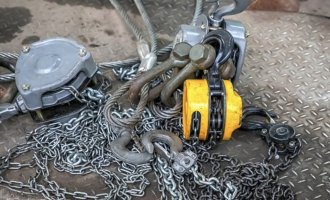1410, PARKSON, 44-60 ZHONGSHAN ROAD, QINGDAO, CHINA
Our effort in pursuing the highest level of technology, products’ quality and customers' satisfaction is never ending.

The chain block is a critical lifting device that requires proper operation and regular maintenance to ensure workplace safety and equipment longevity. This manual provides essential guidelines for safe operation, maintenance procedures, and important safety precautions that must be followed by all operators.

The various components of lifting chains play a crucial role in their safety and reliability. These components include the grade of steel, the diameter of chain, chain legs, component connectors and hooks.

The job of wire rope thimbles is to protect wire rope loops. Wire rope thimbles play a significant role in maintaining the vitality of the wire ropes they support. Wire rope thimbles function as a shield for wire rope loops. When loops are subjected to force, the load becomes concentrated at the apex. The absence of a thimble accelerates stress. Thimbles act as a pad, offering much-needed structural support.

Shackles are one of the most versatile and important pieces of equipment in nearly every rigging, lifting, and material handling operation. They serve as a critical function of connecting various pieces of lifting equipment together. Such a powerful piece of equipment requires proper handling and knowledge in order to unleash its full potential.They are the reason cranes lift and I-beams rise.

Beam clamps are indispensable connecting components in steel structure construction. They are primarily used to quickly and securely connect steel beams or I-beams together, and are widely used in steel structure buildings, bridges, industrial plants, and other fields. This article will elaborate on the structural features, working principles, and key points of installation and usage of beam clamps, helping construction personnel better master the skills of using this product and ensure construction safety and quality.

In various industrial facilities, construction sites, and ports, we often see bolts used for lifting, with slings or wire ropes attached to their eye-shaped heads. These seemingly inconspicuous parts are called Eye Bolts, also known as Lifting Eye Bolts or Eyebolts. They play a crucial role in lifting and hoisting operations. So, what exactly are Eye Bolts? What types are there? And what are they used for? This article will explore these questions in depth.

Safety hooks play a crucial role in lifting, hoisting, and towing operations. Among them, Eye Self-Locking Safety Hooks are widely favored by users for their unique self-locking structure and convenient operation. This article will introduce several common types of Eye Self-Locking Safety Hooks in detail to help you choose the most suitable product.

Plastic chains have become an essential component in various industries due to their versatility, durability, and cost-effectiveness. These chains, made from high-quality polymers, offer a wide range of benefits that make them a popular choice for numerous applications.

Hand winches are essential tools that have proven their worth in various industries and applications. These mechanical devices are designed to lift, pull, or position heavy loads with ease, making them indispensable for many professionals. In this blog post, we'll delve into the world of hand winches, exploring their components, working principles, and the diverse range of applications they serve.